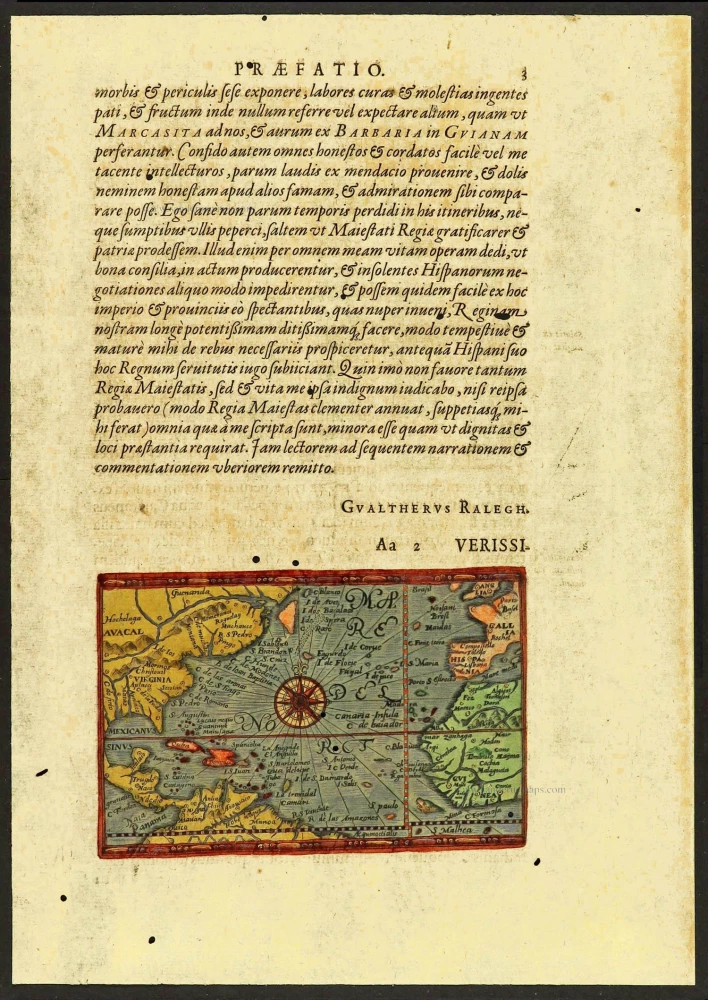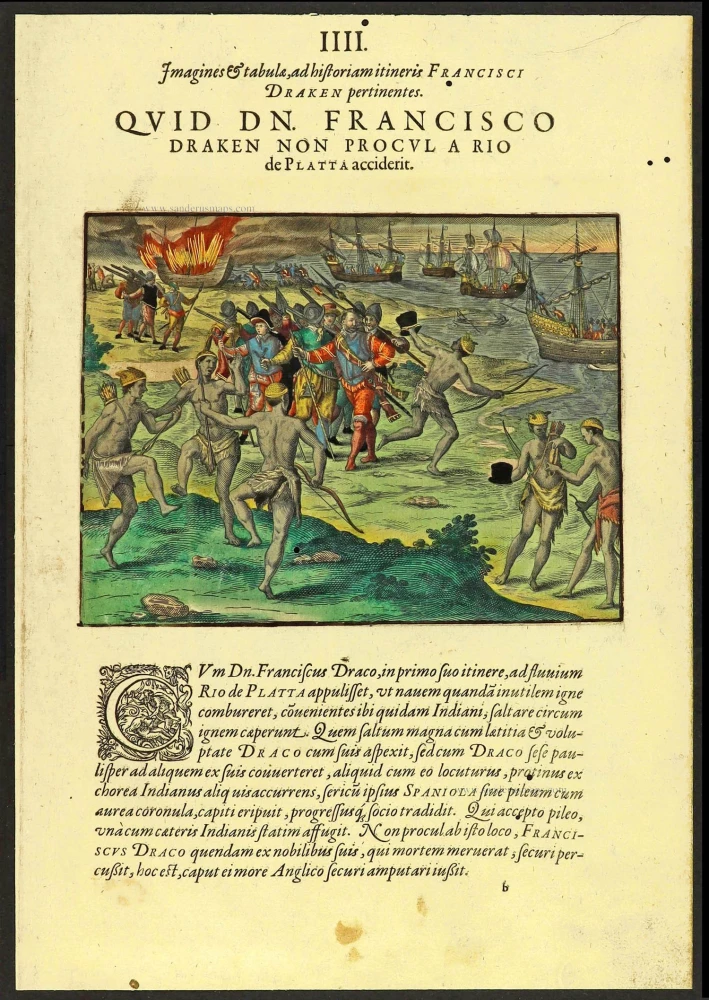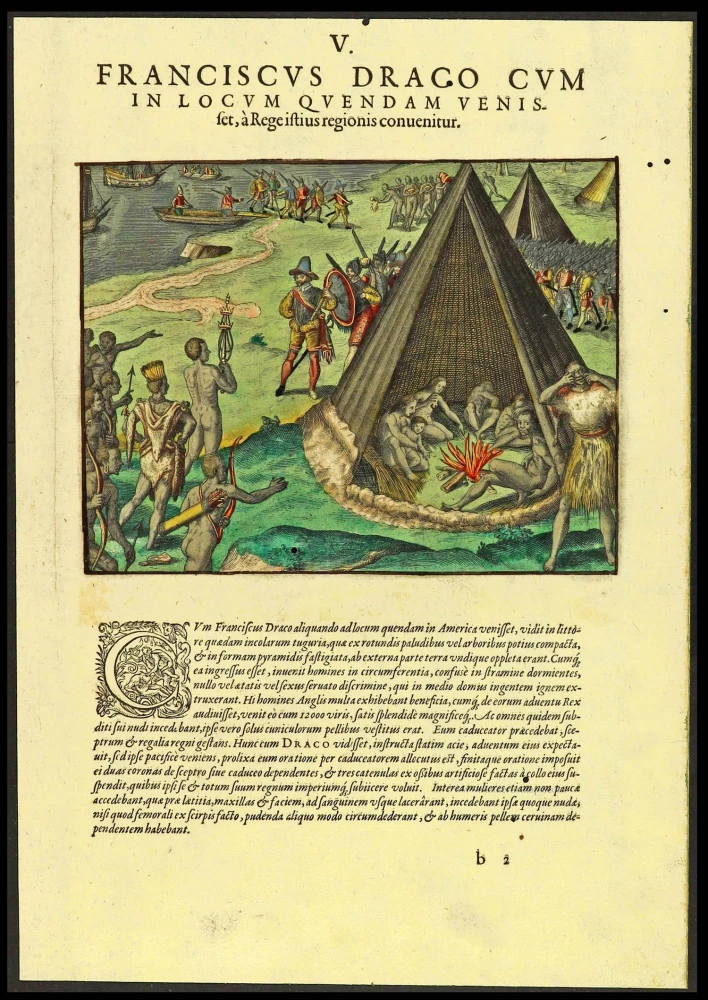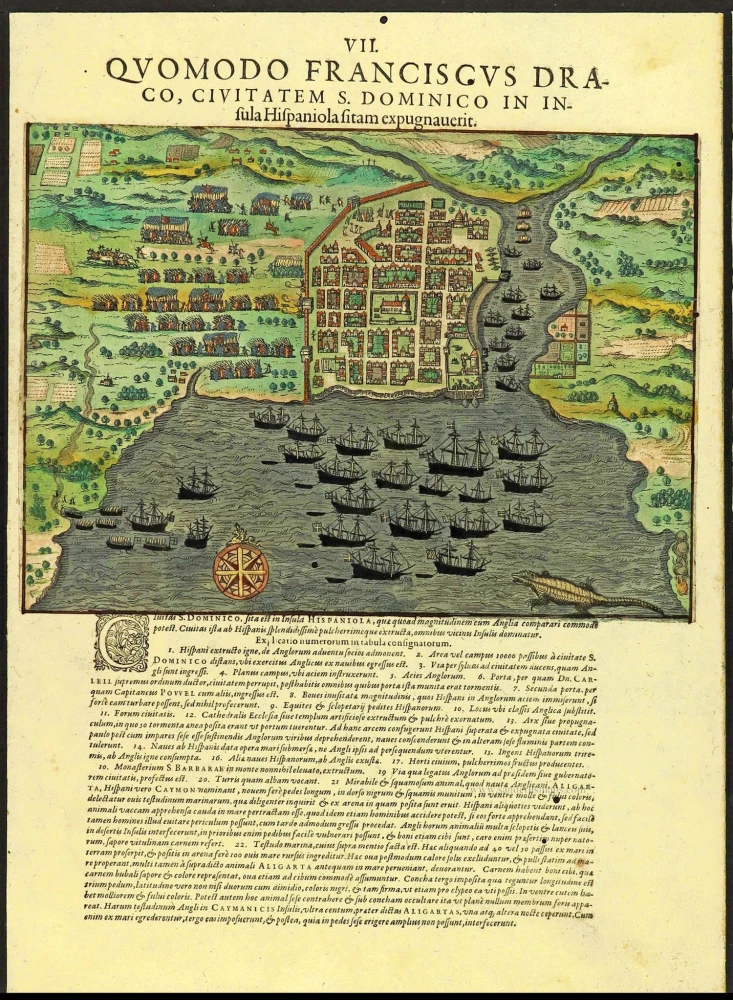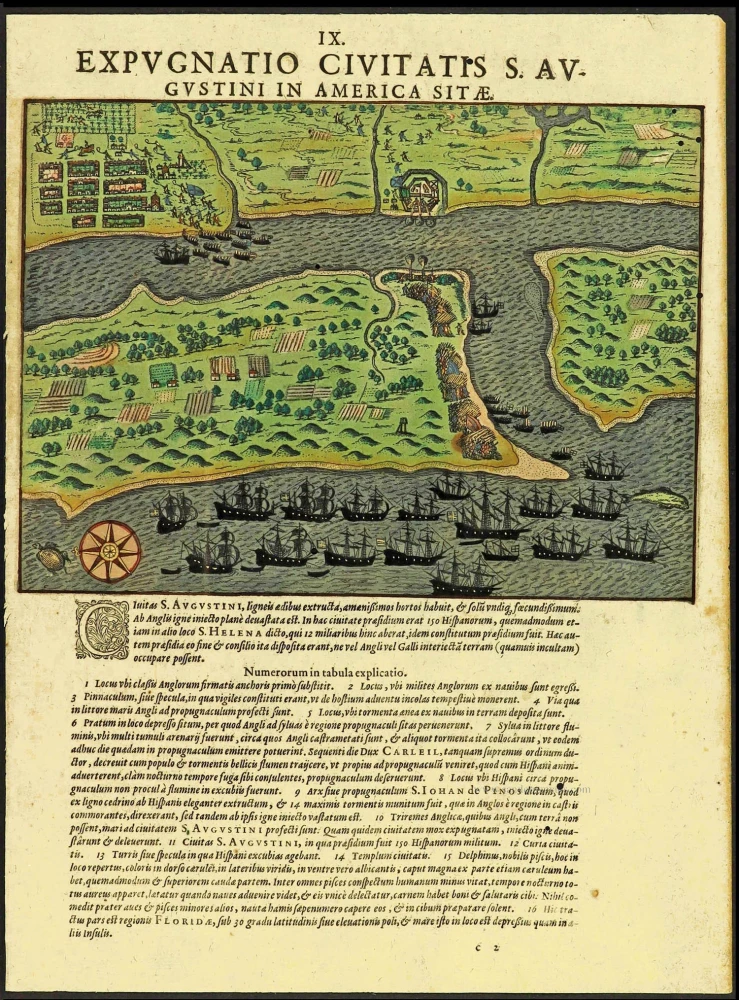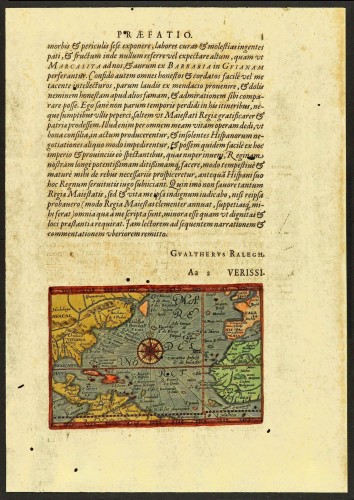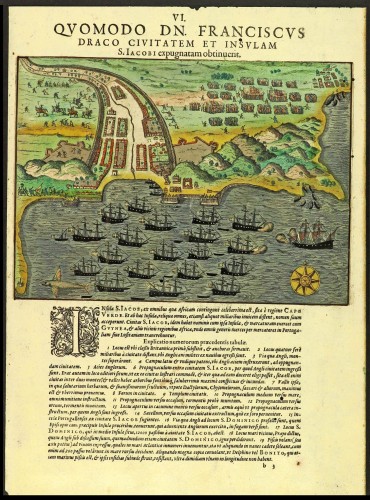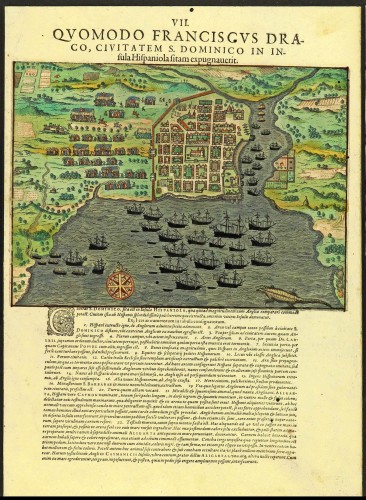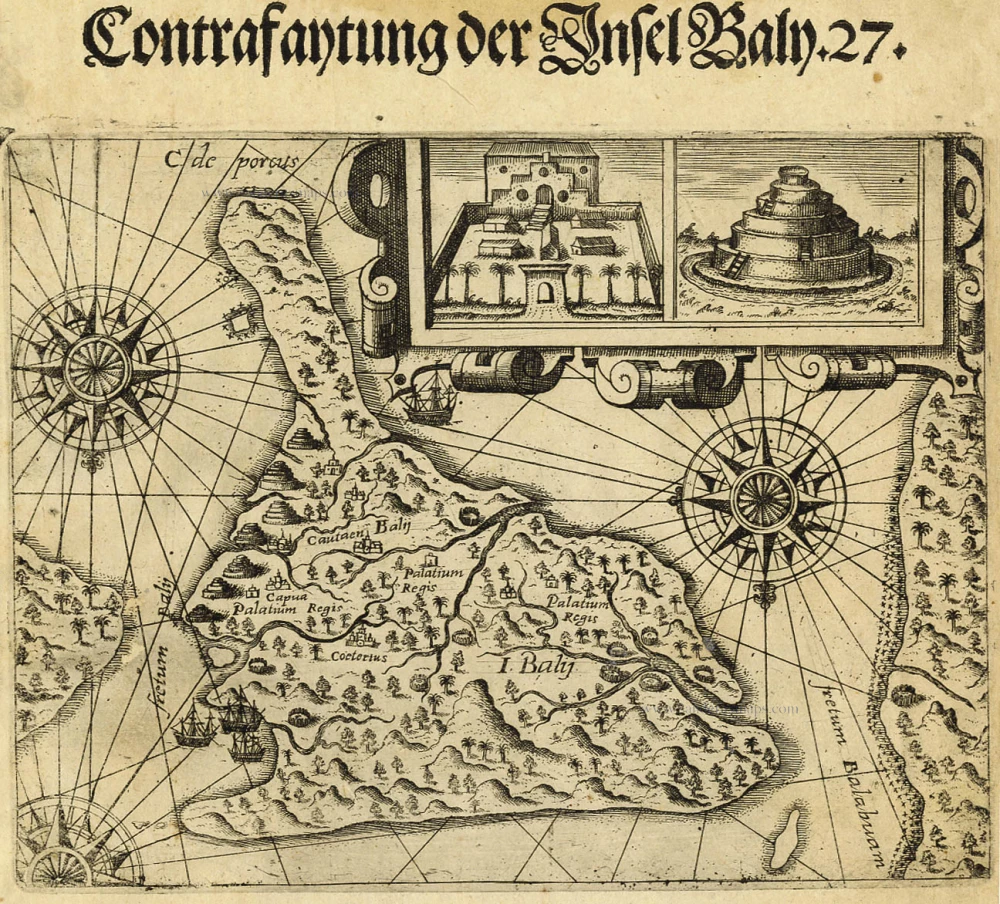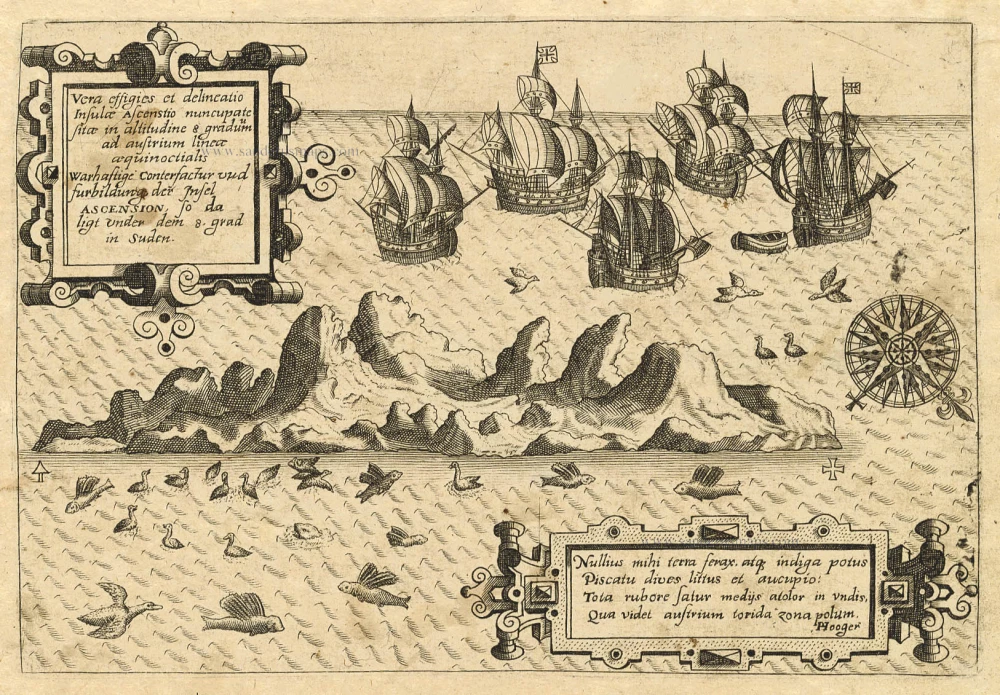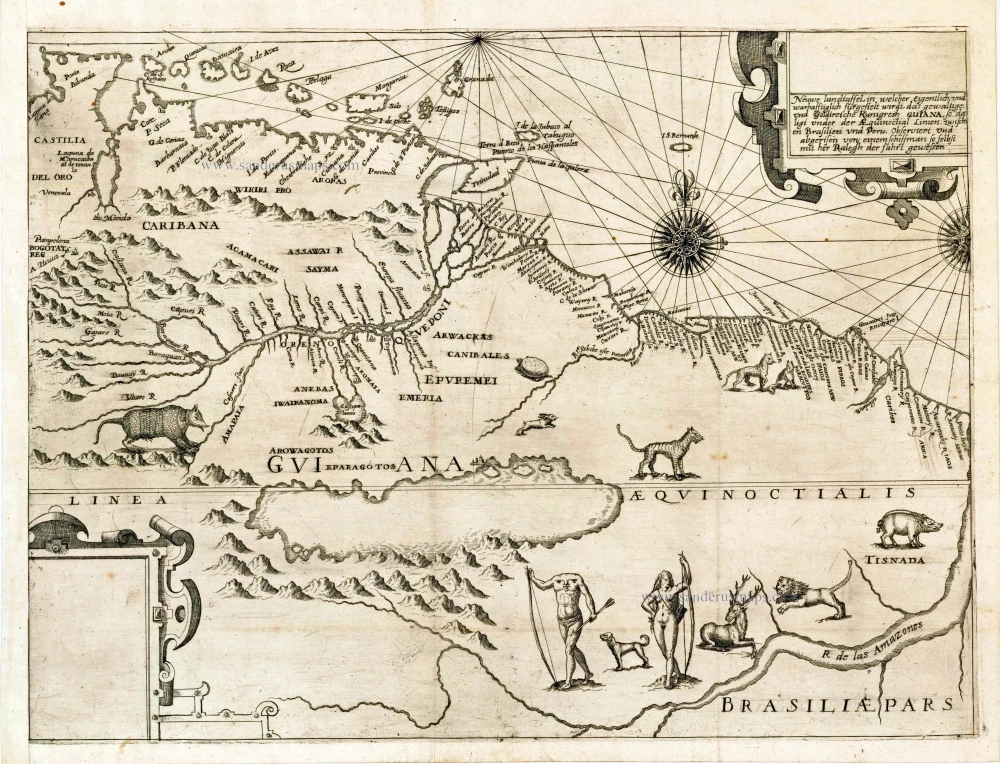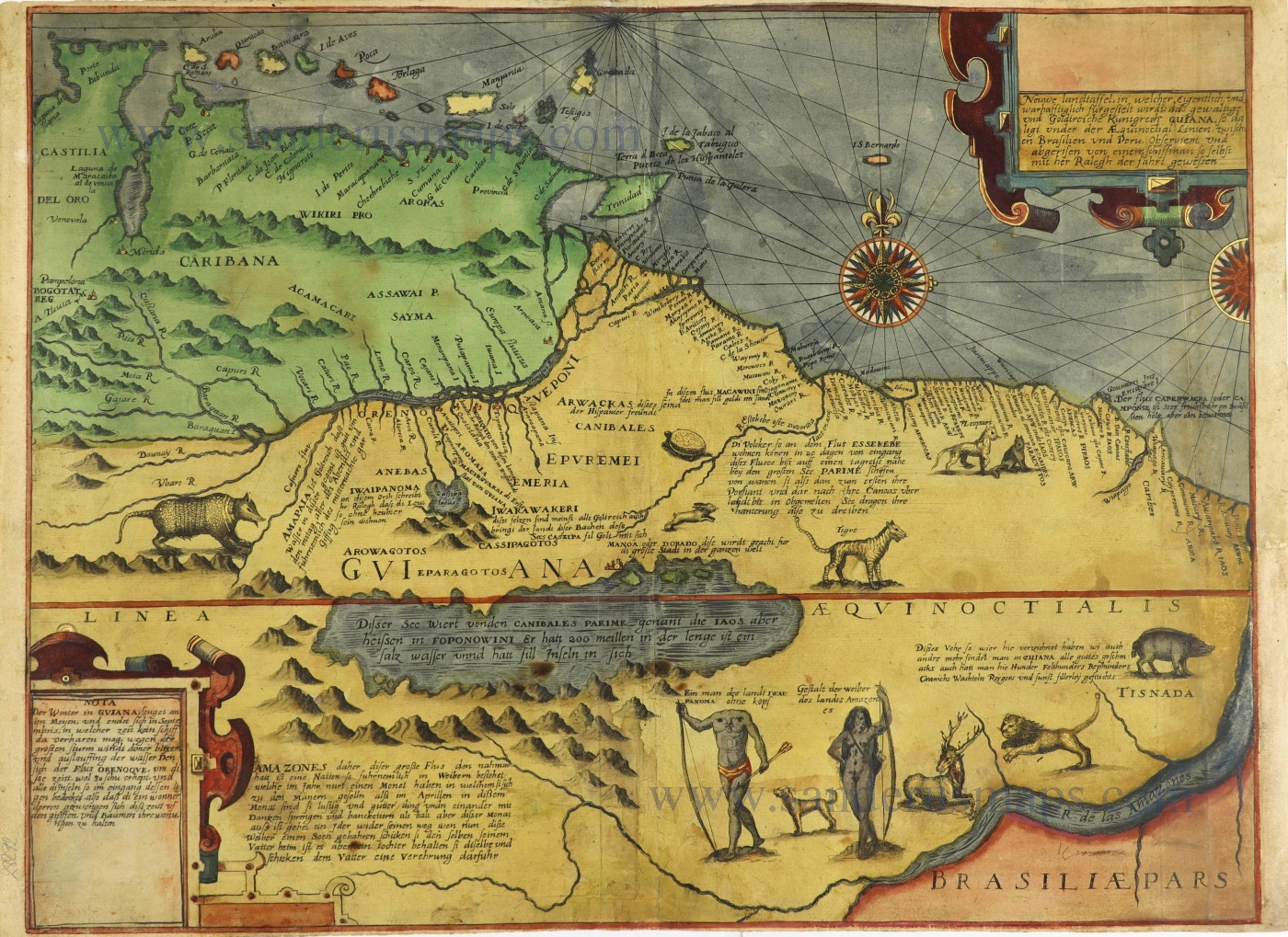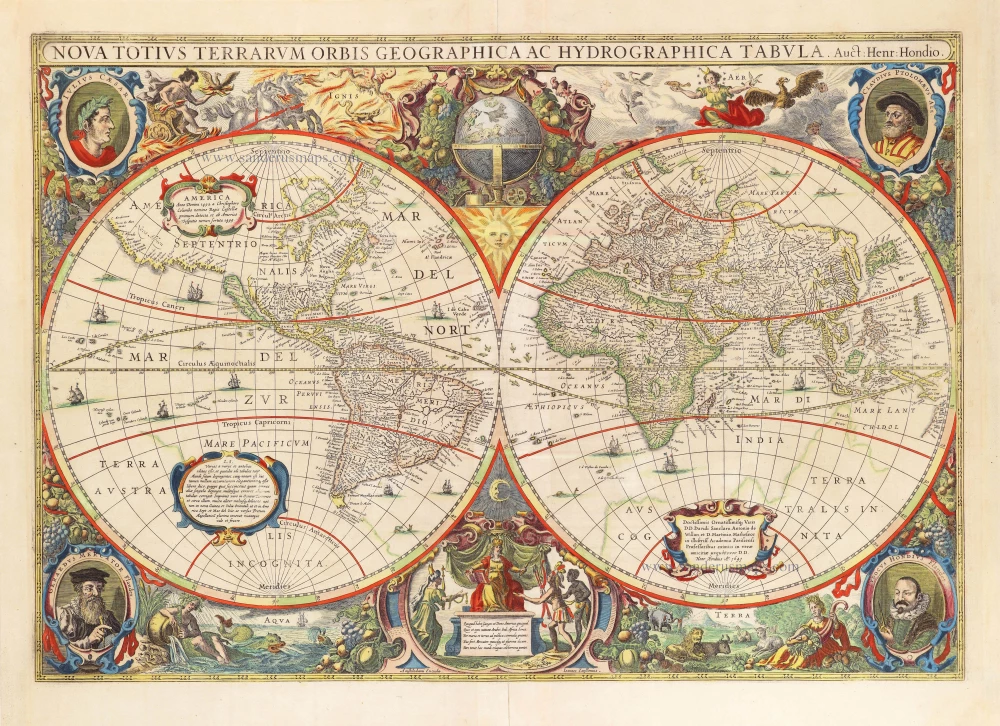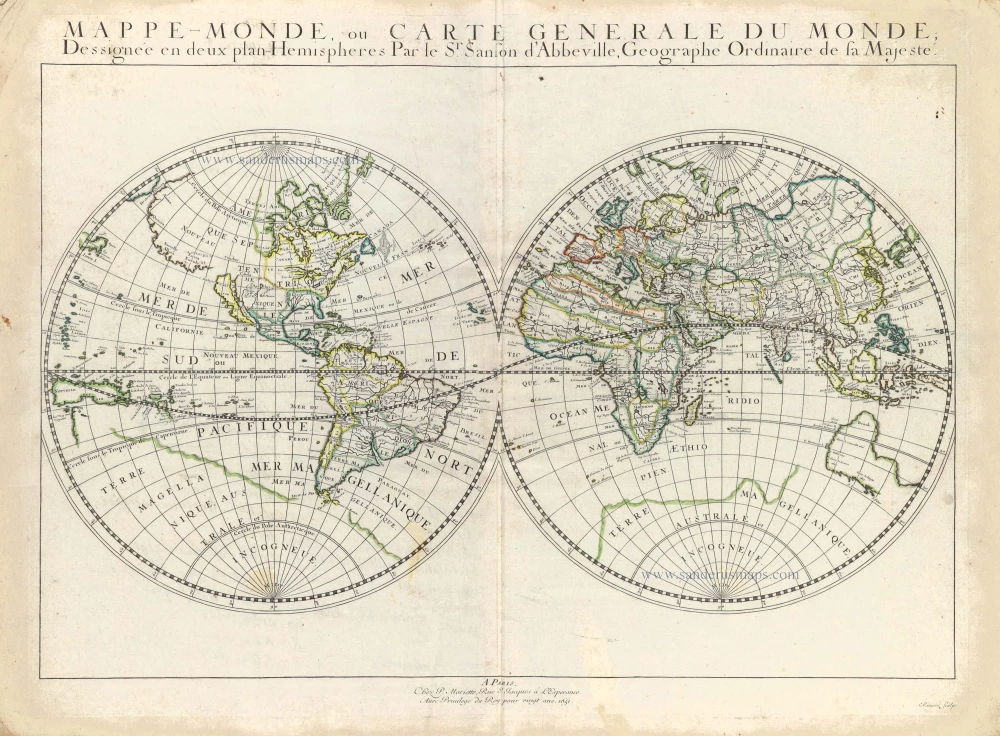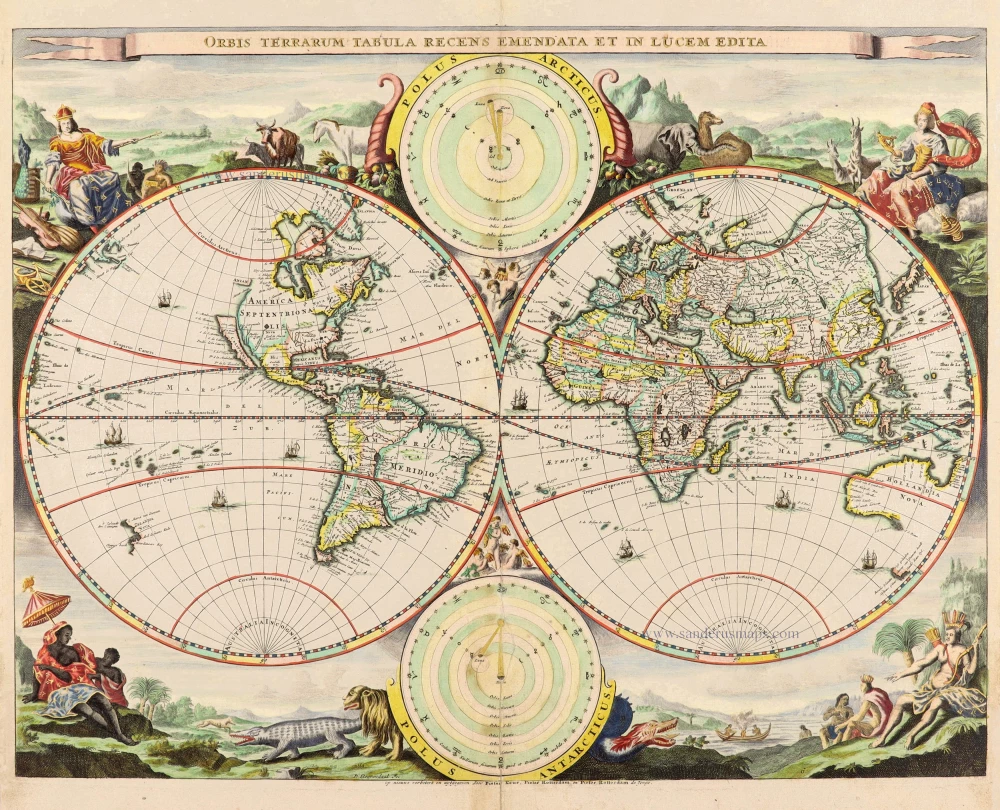Heightened in gold
Drake set in superb old colouring. 1599
In volume VIII, the de Brys returned to the American adventures of Elizabethan England. The pirate raids of Francis Drake and Thomas Cavendish against Spanish interests in the Caribbean in the 1570s and 1580s arguably had more appeal for European readers than the attempts to colonise North Carolina, so it was not surprising that the de Bry brothers collected these accounts. Drake's attack on Cartagena de Indias, one of the major strongholds of Spanish America on the Colombian coast, his subsequent circumnavigation of the globe and his exploration of the area he christened Nova Albion (present-day California) represented the highlights of these expeditions, and the de Brys selected precisely these episodes as the subject matter for their illustrations. The third expedition which received disproportionate attention in Frankfurt was the search for El Dorado, led by Sir Walter Raleigh himself.
The choice for at least some of the accounts the de Brys selected for this volume was conditioned by the increasing dominance in the European book market of publishers from Holland, most notably from Amsterdam. (Van Groesen - Tise)
To illustrate the eighth part of the Grand Voyages, Theodore de Bry used the Baptista Boazio plans of 1588. These depicted the raids of Sir Francis Drake during his famous West Indian voyage of 1585-86.
Theodore de Bry (1528 – 1598) and his family.
Theodore de Bry was born in 1528 in the Prince-Bishopric of Liège in the southern Netherlands (today Belgium). Trained as a goldsmith in his father's workshop, he left his home town around 1558 and moved to Strasbourg. Religious motives partly inspired his emigration, but commercial incentives were probably more critical for de Bry since Strasbourg was more attractive. Here, he gradually began to shift his focus to copper engraving. In the early 1560s, Theodore married Strasbourg-born Katharina Esslinger, and the couple went on to have four children together before Katharina died c. 1569. Johan Theodore (b. 1563) and Johan Israel (b. 1565) followed in their father's footsteps and took up his trade. He remarried in 1570 to Katharina Rölinger.
In 1577, after the Pacification of Gent had quietened religious tensions in the Netherlands, Theodore and his family moved to Antwerp. There, they lived close to the printing house of Christopher Plantin, and it was there that Theodore began making copper engravings. Copper engraving was a well-developed art in the Low Countries, and Antwerp artists were in great demand. In 1584, when Catholic troops besieged Antwerp, Theodore and his family moved to London, where he made copper engravings for an essential English navigation manual, The Mariners Mirrour. He also found the inspiration to produce the collection to which his name would forever be attached.
He met the artist Jacques Le Moyne de Morgues, a draughtsman who had been to Florida in the 1560s as part of a French expedition. He returned to Europe with watercolours of the natural world he had seen and the indigenous peoples. After Le Moyne's death, thanks to the mediation of Richard Hakluyt, Theodore acquired these drawings.
Hakluyt and de Bry began collaborating on a series of books about America. In 1588, the de Bry family moved to Frankfurt, where Theodore published the first volume of the America series. This first volume was the only one in the collection that appeared in four different languages: German, Latin, French and English. The following volumes appeared only in German and Latin. As a result, the relationship between de Bry and his English partners quickly soured.
Theodore continued publishing and produced a blend of richly illustrated prestigious volumes of the Voyages collection, the family firm's flagship publication.
Theodore de Bry died on March 27th, 1598. At this time, the highly successful and lucrative America series had already extended to seven volumes, and there would be fourteen. To these must be added the 'Elenchus', published in 1634 by Merian, which was a collective title and table of contents of these same volumes.
In 1597, the de Bry brothers published the first volume of the East India series. These were also published in folio but with slightly smaller page sizes than the America volumes. To distinguish the East India series from his America series, the two parallel sets subsequently became known among bibliophiles as de Bry’s Petits Voyages and his Grands Voyages, respectively.
The Petits Voyages consist of thirteen volumes, published between 1597 and 1633.
After Theodore de Bry's death, the business was run by his son, Johann Theodore and then by his grandson, Matthäus Merian and grandson-in-law, William Fitzer. Precisely what part de Bry's widow and his other son played in the business is unclear, but they certainly seemed to have retained some interest. After all, it must have become a very profitable venture for the whole family. Together, they continued to publish volumes of the Grands and Petits Voyages for another 46 years. The last volume, a third edition of Part IV of the America series, finally appeared in 1644.
Currently not available
Item Number: 28235 Authenticity Guarantee
Category: Antique maps > America > Central America
Set of antique maps of the World, the Atlantic Ocean, local American maps (4) and two historical scenes relating to Sir Francis Drake, by Theodor de Bry.
The 'Drake' world map and seven others.
World map in two hemispheres. - No title.
Figuris & imaginibus artificiosè illustrata & in lucem emissa, opera & sumptibus Theodorici de Bry P.M. relictae Viduae & filiorum. Anno M.D.XCIX.
= Frontispiece to the Grand Voyages Part VIII.
Shows track of Drake's circumnavigation, with portrait of Drake at top and vignette of his ship below.
Shirley (World), #219 p. XXXV pl. 10; Van Groesen - Tise, p. 302-303.
The de Bry 'Drake' map is the largest and finest of the de Bry's world maps. It is an expertly-engraved reduction of Jodocus Hondius' celebrated broadside map of c. 1595. Because of the rarity of the Hondius broadside the de Bry 'Drake' map is now much sought after by collectors. (Shirley).
The Atlantic Ocean. - No title.
This map depicts the Atlantic Ocean in the Medina type and illustrates the coastline of parts of America, Africa and Europe. Virginia is recorded, showing the account of Drake's visit to Roanoke Island in 1586. It is directly drawn from that of Cornelis Claesz published in 1598.
Burden, #130.
Quid Dn. Francisco Draken non procul a Rio de Platta acciderit.
What happened to Francis Drake not far from the island of Rio de la Plata.
Van Groesen - Tise, Pl. 4
Franciscus Drago cum in locum quendam venis.
How Francis Drake arrives at a place where the king meets him.
Van Groesen - Tise, Pl. 5
Quomodo Dn. Franciscus Draco civitatem et insulam S. Iacobi expugnatam obtinuerit.
How Francis Drake occupied the town and island of St. Iago.
Van Groesen - Tise, Pl. 6
Quomodo Franciscus Draco, civitatem S. Dominico in Insula Hispaniola sitam expugnauerit.
How Captain Francis Drake conquered the town of Santo Domingo on the island of Hispaniola.
Van Groesen - Tise, Pl. 7
Franciscus Draco Carthagenam civitatem expugnat.
The town of Cartagena is won by Francis Drake.
Van Groesen - Tise, Pl. 8
Expugnato civitatis S. Augustini in America sitae.
The conquest of St. Augustine in America.
Van Groesen - Tise, Pl. 9; Burden, #131
Copper engravings, printed on paper.
Size of the sheets: 310 x 230mm (12.2 x 9.06 inches).
Verso: Blank - Atlantic Ocean with Latin text.
Condition: Original coloured, heightened in gold and silver, some worm holes, right margin of world map trimmed.
Condition Rating: A
From: de Bry Theodore, Grand Voyages. - [Voyages of Sir Francis Drake, Thomas Candish and Sir Walter Raleigh.] Americae pars VIII. Continens primo, descriptionem trium itinerum nobilissimi et fortissimi equitis Francisci Draken, qui peragrato primum universo terrarum orbe, postea cum nobilissimo equite Iohanne Hauckens, ad expug-nandum civitatem Panama, in Indiam navigavit, ubi vitam suam ambo finierunt. . . . Frankfurt am Main, 1599.
In volume VIII, the de Brys returned to the American adventures of Elizabethan England. The pirate raids of Francis Drake and Thomas Cavendish against Spanish interests in the Caribbean in the 1570s and 1580s arguably had more appeal for European readers than the attempts to colonise North Carolina, so it was not surprising that the de Bry brothers collected these accounts. Drake's attack on Cartagena de Indias, one of the major strongholds of Spanish America on the Colombian coast, his subsequent circumnavigation of the globe and his exploration of the area he christened Nova Albion (present-day California) represented the highlights of these expeditions, and the de Brys selected precisely these episodes as the subject matter for their illustrations. The third expedition which received disproportionate attention in Frankfurt was the search for El Dorado, led by Sir Walter Raleigh himself.
The choice for at least some of the accounts the de Brys selected for this volume was conditioned by the increasing dominance in the European book market of publishers from Holland, most notably from Amsterdam. (Van Groesen - Tise)
To illustrate the eighth part of the Grand Voyages, Theodore de Bry used the Baptista Boazio plans of 1588. These depicted the raids of Sir Francis Drake during his famous West Indian voyage of 1585-86.
Theodore de Bry (1528 – 1598) and his family.
Theodore de Bry was born in 1528 in the Prince-Bishopric of Liège in the southern Netherlands (today Belgium). Trained as a goldsmith in his father's workshop, he left his home town around 1558 and moved to Strasbourg. Religious motives partly inspired his emigration, but commercial incentives were probably more critical for de Bry since Strasbourg was more attractive. Here, he gradually began to shift his focus to copper engraving. In the early 1560s, Theodore married Strasbourg-born Katharina Esslinger, and the couple went on to have four children together before Katharina died c. 1569. Johan Theodore (b. 1563) and Johan Israel (b. 1565) followed in their father's footsteps and took up his trade. He remarried in 1570 to Katharina Rölinger.
In 1577, after the Pacification of Gent had quietened religious tensions in the Netherlands, Theodore and his family moved to Antwerp. There, they lived close to the printing house of Christopher Plantin, and it was there that Theodore began making copper engravings. Copper engraving was a well-developed art in the Low Countries, and Antwerp artists were in great demand. In 1584, when Catholic troops besieged Antwerp, Theodore and his family moved to London, where he made copper engravings for an essential English navigation manual, The Mariners Mirrour. He also found the inspiration to produce the collection to which his name would forever be attached.
He met the artist Jacques Le Moyne de Morgues, a draughtsman who had been to Florida in the 1560s as part of a French expedition. He returned to Europe with watercolours of the natural world he had seen and the indigenous peoples. After Le Moyne's death, thanks to the mediation of Richard Hakluyt, Theodore acquired these drawings.
Hakluyt and de Bry began collaborating on a series of books about America. In 1588, the de Bry family moved to Frankfurt, where Theodore published the first volume of the America series. This first volume was the only one in the collection that appeared in four different languages: German, Latin, French and English. The following volumes appeared only in German and Latin. As a result, the relationship between de Bry and his English partners quickly soured.
Theodore continued publishing and produced a blend of richly illustrated prestigious volumes of the Voyages collection, the family firm's flagship publication.
Theodore de Bry died on March 27th, 1598. At this time, the highly successful and lucrative America series had already extended to seven volumes, and there would be fourteen. To these must be added the 'Elenchus', published in 1634 by Merian, which was a collective title and table of contents of these same volumes.
In 1597, the de Bry brothers published the first volume of the East India series. These were also published in folio but with slightly smaller page sizes than the America volumes. To distinguish the East India series from his America series, the two parallel sets subsequently became known among bibliophiles as de Bry’s Petits Voyages and his Grands Voyages, respectively.
The Petits Voyages consist of thirteen volumes, published between 1597 and 1633.
After Theodore de Bry's death, the business was run by his son, Johann Theodore and then by his grandson, Matthäus Merian and grandson-in-law, William Fitzer. Precisely what part de Bry's widow and his other son played in the business is unclear, but they certainly seemed to have retained some interest. After all, it must have become a very profitable venture for the whole family. Together, they continued to publish volumes of the Grands and Petits Voyages for another 46 years. The last volume, a third edition of Part IV of the America series, finally appeared in 1644.



